|
The leather Industry holds a prominent place in the Indian economy known for its consistency in high export earnings and it is among the top ten foreign exchange earners for the country. The Leather industry is bestowed with an affluence of raw materials as India is endowed with 21% of world cattle & buffalo and 11% of world goat & sheep population.
Leather Industry is categorized into segments such as finished leather, Footwear, Leather Garments, and Goods & Accessories sector including Saddlery & Harness. India is second largest producer in both leather footwear and leather garments sectors while in exports the Country stands third in leather garments and fifth in leather goods & accessories sectors.
India continues to stand at eighth place in the world leather exports with 3% of part in the total export earnings. China and Italy enjoys the largest market share of about 28% and 14% in world exports respectively followed by Hong Kong, Germany, France, Brazil and Belgium.
Leather industry exports increased 29% in USD terms while 31% in rupee terms
As per officially notified DGCI&S monthly export data, the leather and leather products exports for the first eight months ended FY12, i.e., April-November 2011 touched USD 3092.02 million as against the export of USD 2398.32 million in the corresponding period last year, registering a positive growth of around 29%. While, in rupee terms, the export touched Rs 143613.68 million during April-November 2011 against Rs 109655.4 million, registering a positive growth of around 31%.
In the ten months ended FY2012 Germany topped with 15% of the India's leather product exports, followed by UK 11.44% and Italy 11.40%. These three countries together accounts for nearly 38% of India's total leather products. Among the major countries, except Germany and China the other countries lost their market share in the Indian leather exports. U.K lost its market share by 152 bps, Italy by 19 bps, France by 84 bps, Hong Kong by 176 bps compared to the corresponding period of last year due to Euro zone debt crisis.
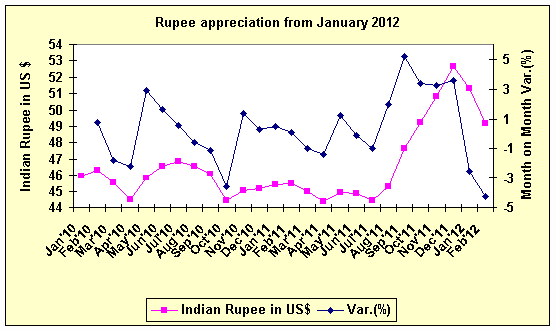
The data for the above graph is culled by taking the daily RBI reference rate from January 2010 to February 2012 and averaged it for the whole month.
Indian leather industry exports grew by almost 31% in rupee terms and 29 % in USD terms led by the Indian rupee depreciation sequentially as well on y-o-y basis since September 2011. However the Indian rupee appreciation during April-August 2011 both sequentially and yearly basis has restricted the exports in growing widely further in rupee terms.
. But, the exports realization growth in rupee terms is likely to come down slightly in the near future with the rupee appreciation since January 2012 coupled with the gloomy economic outlook scenario in UK, Italy, and France in particular. However, the healthy demand from Germany accompanied by recovery in US economy and easing of monetary policy in China are showing some positive signs to the Indian leather industry exports
The sound growth in exports of leather industry India was attributed by increased exports of leather garments and goods & footwear components. Also, the strong dollar appreciation against Indian rupee during September and November2011 has facilitated the sector to witness high growth export earnings in Rupee realization.
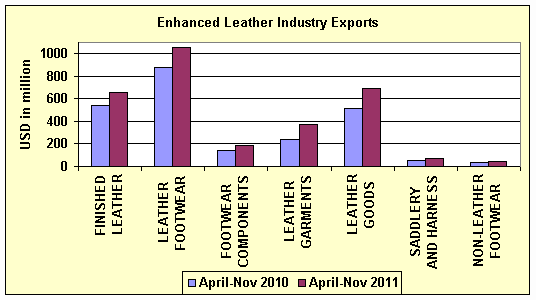
During the April-November 2011 period, leather footwear exports grew by 23% to Rs 49110.05 million in rupee terms and grew by 21% to Rs 1057.35 million in USD terms. The major production centers for footwear in India are Chennai, Ranipet, and Ambur in Tamil Nadu, Mumbai in Maharashtra, Kanpur in U.P, Jalandhar in Punjab, Agra, Delhi, Karnal, Ludhiana, Sonepar, Faridabad, Pune, Kolkota, Calicut and Ernakulam
Both Leather garments and leather goods & saddlery products form significant segments of the leather industry India. Leather Garments segment exports grew by sharp 59% to Rs 17483.5 million while in dollar terms it grew by 57% to USD 376.42 million.
Besides, leather goods exports improved by 37% to Rs 32091.25 million while in USD terms it improved by 35% to $512.06 million. On the other hand, Saddlery and harness segment exports grew 34% in rupee terms while 32% in USD terms
Footwear components exports increased by 38% to Rs 8857.66 crore in rupee terms while it has grown by 36% to $140.35 million in USD terms.
Finished leather segment exports jumped up by 24% to Rs 30690.37 million in rupee terms and 22% to USD 660.77 million in dollar terms. Meanwhile, non-leather footwear exports grew by 32% in rupee terms while 30% in USD terms.
During the period April-Nov 2011, in USD value terms, leather footwear segment by and large occupied the highest market share in the total exports accounting to 34%, but declined by 230 bps against corresponding period of last year. Leather goods occupied 22% and inclined by 100 bps, finished leather constituted 21% but reduced by 123 bps amid leather garments contributed 12% and improved by 216 bps, footwear components such as shoe uppers, soles, etc constituted about 6% and improved by 32 bps and non leather footwear and saddlery & harness segments together accounts 4% to the total exports and remained constant when compared to the corresponding period of last year.
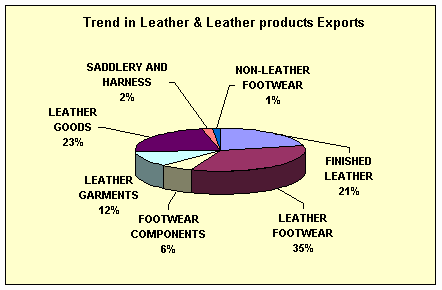
Background
The leather manufacturing process is divided into three fundamental sub processes, preparatory stages, tanning and crusting.
The preparatory stages are when the skin is prepared for tanning. It may include preservation, soaking, liming, unhairing, fleshing, splitting frizzing and pickling etc.
Tanning is the process, which converts the protein of the skin into a stable material, which will not putrefy and is suitable for a wide variety of end applications. Several tanning processes transform skins into leather.
Crusting is the process by which skin is thinned, retanned and lubricated. Often a coloring operation is included in the crusting sub process.
In general leather is sold in four forms. They are: Full grain leather refers to hides that have not been sanded, buffed to remove imperfections on the surface of the hide. High quality leather furniture and footwear are often made from full-grain leather. Next we have top-grain and corrected grain where both are sanded off, these are second highest quality of leather. Next we have split leather, which is created from the fibrous part of the skin left once the top grain of the rawhide has been separated from the hide.
Leather & leather products production improved sequentially except leather bags, purses and wallets
During December 2011, the leather, leather garments and leather gloves production improved while leather items such as bags, purses and wallets, leather shoes and shoes uppers and footwear (except leather) production declined on yearly basis. On sequential basis, except leather items such as bags, purses and wallets all other leather and leather products production improved.
In value terms the production of tanned or chrome skins and leathers enhanced by 29% on y-o-y basis and grew by 2% to Rs 86 crore on monthly basis. Like wise, leather garments production jumped by 39% on yearly basis and also increased by 35% to Rs 40.8 crore on m-o-m basis.
The production of major leather items such as bags, purses and wallets declined by 16% to 4,71,685 in numbers on yearly basis and drastically fell down by 30% on sequential basis. Leather shoes production slipped by 1% on yearly basis while on sequential front it increased by 12% to 3015.7 thousand pairs.
Leather shoes uppers production dented by 15% on y-o-y basis and improved sequentially by 22% to 1526 thousand pairs. Similarly, leather gloves production jumped up by 30% on yearly basis and 35% on monthly basis accounting to 1723.3 thousand pairs.
Whilst, the footwear expect leather production declined by 3% on yearly front while improved by 12% on monthly basis.
In the first nine months ended FY12, the production of tanned skins & leathers improved by 21%, leather garments by 18%, leather bags, purses and wallets by 25%, leather gloves by 3% and leather shoes by another 3% while shoe uppers production declined by 6% and footwear except leather remained flat when compared to the corresponding period of last year.
Leather & leather products price Index increased on y-o-y in Jan 2012
In January 2012, leather and leather products price index increased on y-o-y basis on disparity between supply and demand.
Based on type of tanning, leather is classified into different types. They are Vegetable tanned leather, where the skin is tanned using tannin and other ingredients found in vegetable matter, such as tree bark prepared in bark mills.
Next is Chrome –tanned leather, where the skin is tanned using chromium sulfate and other salt s of chromium. It is most supple and pliable than vegetable –tanned leather and doesn't discolor or lose shape as drastically in water as vegetable –tanned. Similarly, we have formaldehyde, brain tanned, Chamois leather which all comes under category of aldehyde tanned leather and others like synthetic tanned leather, alum tawed leather.
The price index of chrome-tanned leather grew by 4.27% on y-o-y basis but fell by flat 1% January 2012 on m-o-m basis .The leather price index has been declined by 2.37 % in Jan 2012 from the peak in July 2011 with improved availability of leather.
The price index of leather & leather products increased by 6.49% on y-o-y basis while remained almost flat on sequential front in Jan 2012. Besides this, leather footwear price index grew by 8% on y-o-y basis while fell by flat 1% on m-o-m basis in January 2012.The price index of other leather products sequentially improved by flat 1% in January 2012 and increased by 11% on y-o-y basis.
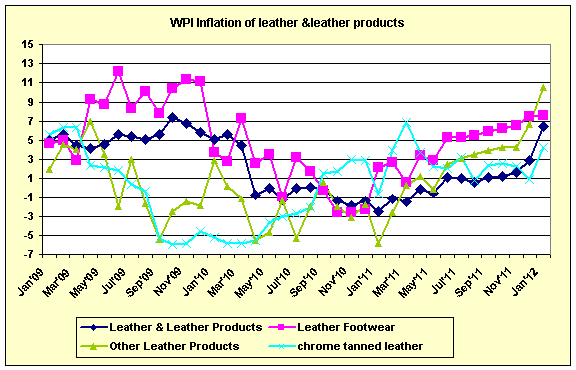
Bata India net profit grew 47% in Dec 2011(y-o-y)
Footwear major, Bata India reported net sales at Rs 369.99 crore, higher by 27% in Q3 FY12 on y-o-y basis. Its operating profit increased by 43% to Rs 53.53 crore as OPM improved by 170 bps to 14.3% on y-o-y basis. Decline in raw material costs as % of adjusted sales by 292 bps to 15%, fall in employee expenses by 330 bps to 10% followed by ease in other expenses by 60bps to 15% led the OPM to improve during the quarter. Hence, increase in sales and improvement in margins led the net profit to grew by 47% on y-o-y basis to Rs 30.42 crore in Q3 FY12.
Liberty Shoes net profit declined 26% (y-o-y) in Q3 FY12 on spurt in interest costs
Liberty shoes which is into manufacturing leather shoes, non-leather shoes and leather shoe uppers reported net sales at Rs 84.13 crore, higher by 2% in Q3 FY12 on y-o-y basis. The operating profit grew by 4% to Rs 7.25 crore on increase in OPM by 15 bps to Rs 8.6 crore. Decline in raw material costs by 163 bps to 41% and ease in employee expenses by 83 bps to 11% led the OPM to improve. But, spurt in interest costs by 58% to Rs 2.94 crore coupled with the rise in depreciation costs by 10% led the net profit to decline by 26% on y-o-y basis to Rs 2.52 crore in Q3 FY12.
Relaxo Footwear net profit grew by healthy 80% in Q3 FY12 (y-o-y)
Relaxo footwear, a part of Relaxo Group, which has major interest in Footwear production, reported net sales at Rs 204.15 crore, higher by 34% in Q3 FY11 on y-o-y basis and recorded its operating profit at Rs 19.15 crore, higher by 36% on improvement in OPM by 20 bps to 9.3%. Decline in raw material costs as % of adjusted sales by 300 bps to 46%, fall in purchase of finished goods costs by 204 bps to 8% despite of rise in employee expenses by 160 bps to 12% and jump in other expenses by 240 bps to 25% set the OPM to improve by 20 bps. Therefore, increase in net sales and margins coupled with the reduction in tax costs by whooping 789% to Rs 2.55 crore led the net profit to grew by healthy 80% to Rs 6.02 crore.
BIL project (line 1) of leather accessories unit (SEZ) is likely to commence in April 2012
Bhartiya International (BIL) which is into leather garments, fashion accessories and textile apparels recorded its net sales for the quarter ended Dec 2011 at Rs 65.71 crore, higher by 36% on y-o-y basis. Followed by net sales, increase in OPM by 500 bps to 10% on decline in other expenses as % adjusted sales by 392 bps to 25% and employee expenses by 110 bps to 3% coupled with the fall in purchases costs by 480 bps to 3% led the operating profit to grew by whooping 167% to Rs.6.37 crore. However, on the account of forex loss of Rs 1.6 crore in Q3 FY12 against gain of Rs 0.93 crore in Q3 FY11 and spurt in interest costs by 35% to Rs 2.18 crore limited the growth in net profit to 46% to Rs 1.77 crore in Q3 FY12 on y-o-y basis.
Bhartiya Urban a realty company, has planned to invest about Rs 10,000 crore in the next ten years to develop a township in Bangalore. They are developing an integrated township " Bhartiya City " in North Bangalore spread over 125 acres. This would be developed in eight phases and involves a total built up area of 17 million sq. ft, which includes 7 million sq ft of housing and 3 million sq. ft of an IT SEZ. Bhartiya Urban's 26% share is held by Infrastructure Leasing and Financial Services (IL & FS), 44% stake by Bhartiya Group promoters and the remaining 30% stake held by Bhartiya International.
The first phase would be developed with 3 million sq. ft at a cost of Rs 1600 crore and for this a loan of Rs 550 crore has been tied from banks. It is an inclusive project, as apartments would be offered to customers in a price range of Rs 10-60 lakh. With the infrastructure work at the project site underway, the construction of the first phase of residential and commercial projects is scheduled to begin in March 2012.
As per the management of Bhartiya international, it is not likely to invest any further or provide any direct or indirect debt support to the project of Bhartiya Urban.
The company has a capex plan of Rs 50 crore over FY12-FY13 for setting up a manufacturing unit for leather accessories in a portion of the 200 acres special economic zone at Nellore, AP.The project line 1 is likely to commence operations in April 2012.
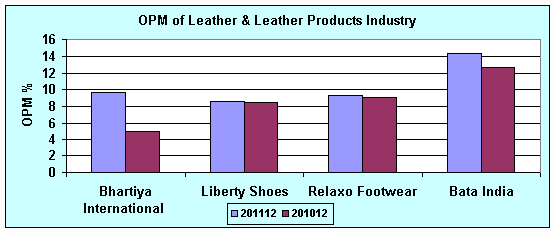
Outlook
The Indian leather & leather products is in demand for its quality, finish and designs. Further, the demand is expected to grow considering the change in life style and affordability for the Indian leather industry. Players that regularly review their product range and adapt to changing requirements of the customers are better placed. Value engineering and improving productivity besides reducing operating cost are the key.
The leather availability is less during the summer season when compared to the rainy and winter seasons. As a result, the leather prices during the summer season generally picks up due to scarcity of leather in quality as well in quantity terms. Therefore, the leather prices are expected to remain stable till the early March 2012 and are likely to move north side from mid of March 2012 with the beginning of summer season.
The on going sovereign debt crisis in UK, Spain and Italy (accounting about 30% to the total exports) can depress the growth of the Indian leather exports into these regions in the short to medium term. Amidst, the leather industry exports are expected to show a significant growth in rupee terms in December 2011 on the back of continued rupee depreciation. Since January 2012, there has been massive appreciation of Indian rupee, which coupled with sluggishness in leather exports to UK, Italy and France is a cause for concern. The risks to global economy and the deceleration in emerging economies like India, China also adds to concerns. These factors have rubbed off the sheen for the Indian leather industry. But the sector is poised for medium term growth, considering its initiatives to move up the value chain, and its plans to expand its geographical reach.
|